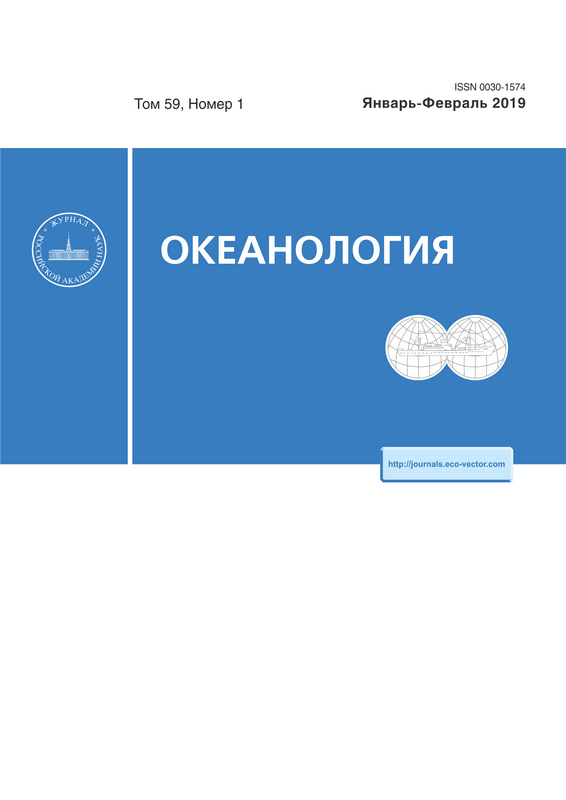О возможности присутствия кислорода в верхнем слое осадков сероводородной зоны Черного моря
- Авторы: Стунжас П.А.1, Гулин М.Б.2, Зацепин А.Г.1, Иванова Е.А.2
-
Учреждения:
- Институт океанологии им. П.П. Ширшова РАН
- Институт морских биологических исследований им. А. О. Ковалевского РАН
- Выпуск: Том 59, № 1 (2019)
- Страницы: 166-169
- Раздел: Информация
- URL: https://journals.eco-vector.com/0030-1574/article/view/11839
- DOI: https://doi.org/10.31857/S0030-1574591166-169
- ID: 11839
Цитировать
Полный текст
Аннотация
В северо-восточной части Черного моря произведен поиск в гипоксийных и аноксийных условиях живых организмов эукариот (микро- и мейозообентоса), а также измерение О2 в придонном слое воды и в верхнем слое осадков.Результаты показывают наличие глубинного максимума численности зообентоса в диапазоне глубин 215-244 м. Данное скопление бентосной фауны охватывает повертикали слой в 30 м. В целом, доля активного мейобентоса не превышала 1.5% от общего числа обнаруженных в пробе организмов. Наличие аэробного бентоса в районе верхней границы Н2S можнообъяснить: сползанием осадков с меньшей глубины; квазипериодической поставкой О2 за счет колебания положения изопикн и/или опускания вод вдоль склона в придонном экмановском слое. Также, при физическом поступлении в придонный слой кислорода, он сравнительно долго может сохраняться в верхней части зоны H2S в виду отсутствия глубинного потока Mn+2 и реакции с ним.
Об авторах
П. А. Стунжас
Институт океанологии им. П.П. Ширшова РАН
Автор, ответственный за переписку.
Email: pastunzhas@mail.ru
Россия, Москва
М. Б. Гулин
Институт морских биологических исследований им. А. О. Ковалевского РАН
Email: pastunzhas@mail.ru
Россия, Севастополь
А. Г. Зацепин
Институт океанологии им. П.П. Ширшова РАН
Email: pastunzhas@mail.ru
Россия, Москва
Е. А. Иванова
Институт морских биологических исследований им. А. О. Ковалевского РАН
Email: pastunzhas@mail.ru
Россия, Севастополь
Список литературы
- Гулин М.Б. Батиметрическое распределение живых активных форм зообентоса в хемоклине Черного моря // Морской экологический журнал. 2013. Т.12. № 1. С. 5–17.
- Елкин Д.Н., Зацепин А.Г., Подымов, О.И., Островский А.Г. Опускание вод в экмановском слое, образованном прибрежным даунвеллинговым течением над наклонным дном // Океанология. 2017. Т. 57. № 4. С. 531–537.
- Зайцев Ю.П., Анцупова Л.В., Воробьева Л.В. и др. Нематоды в глубоководной зоне Черного моря // Докл. АН УССР. Сер. Б. 1987. № 11. С. 77–79.
- Зацепин А.Г., Островский А.Г., Кременецкий В.В. и др. Подспутниковый полигон для изучения гидрофизических процессов в шельфо-склоновой зоне Черного моря // Физ. атмосф. и океана. 2014. №1. С.16–29.
- Сергеева Н.Г. К вопросу о биологическом разнообразии глубоководного бентоса Черного моря // Экология моря. 2000. Вып. 50. С. 57–62.
- Стунжас П.А., Мошаров В.Е., Радченко В.Н. Возможности фотолюминесцентного метода измерения концентрации кислорода в редокс зоне Черного моря в сравнении с другими методами // Океанология. 2013. Т. 53. № 4. С. 507–516.
- Luth U., Luth C.M. A benthic approach to determine long-term changes of the oxic/anoxic interface in the water column of the Black Sea / Proc. 30th Europ. Mar. Biol. Symp. (Southampton, UK, Sept 1995). Southampton, 1997. P. 231–242.
- Sergeeva N.G., Gulin M.B. Meiobenthos from an active methane seepage area in the NW Black Sea // Marine Ecology an Evolutionary Perspective, Special topics volume ‘Ecology and evolution of vent, seep and whalefall organisms’. 2007. V. 28. 1. P. 152–159.
Дополнительные файлы









